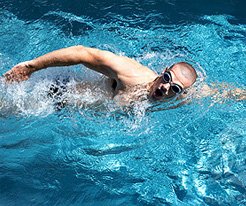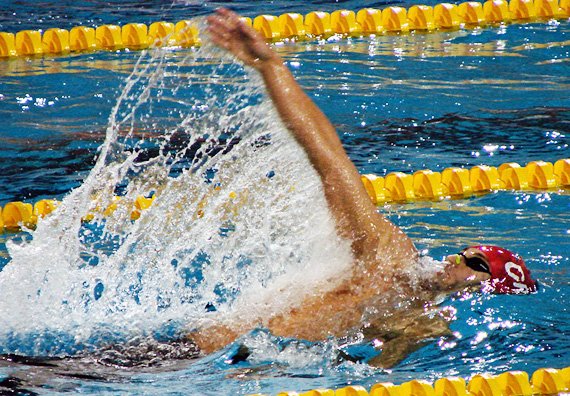From the moment human beings find themselves immersed in water, several things become apparent: It takes a lot of energy to stay afloat, the body needs to move in unfamiliar ways, using unfamiliar muscles, and motivation!? What's more immediate than sink or swim?
People swim to survive floods, cross rivers, escape shipwrecks. Staving off disaster rarely incurs such pleasant physical results. You can achieve life-saving benefits - more muscle, greater endurance, major calorie burn - in the safe confines of a community pool.
All you need to know is:
- Which muscle group each stroke engages
- Where swimming fits in your broader regimen
- How to fuel for the pool
Before we hit the water, if you still think swimming isn't for you, consider that it's non-impact in nature, meaning it's terrific for those who suffer from joint pain. Whether you have knee, back or ankle pain, swimming provides cardiovascular workouts without irritating injuries.

Different Strokes
Different swimming strokes target different muscle groups, so for optimal benefits, vary your stroke selection. Bear in mind that your least-favorite stroke may do you the most good.
It will work muscles that may be weaker in the body, helping you overcome muscular imbalances.
The Front Crawl

The front crawl stroke is great for those who enjoy faster paced swimming because it generates the most force.
This stroke recruits the chest muscles, the lats, and other back muscles.
Because this exercise requires rapid movement of the arms, going from above the head to down by the sides of the body, you'll tap into your fast-twitch muscle fiber potential, leading to improvements in speed and power.
The Backstroke
This stroke is less intensive than the front crawl or breaststroke. If you're doing a recovery swim between intense workouts at the gym, this should be your go-to stroke.
Not surprisingly, this stroke will hammer your back. Your lats pull your arms beneath the water and then back to the surface again.
Your hamstrings come into play slightly more due to the back-down position. This muscle group propels you via the flutter kick, which helps drive the body forward.

The Breaststroke
The breaststroke is one of the most popular swimming strokes and involves your lower and upper body moving in sync. The breaststroke is swum in a prone position, with both arms moving synchronously in short, half-circular movements under water. The legs also move synchronously and execute a whip kick.
The breaststroke is great for any beginner because it's easy on the body. You don't have to exert a ton of effort, so it's easier to swim several laps before getting fatigued.
The Butterfly

Finally, the stroke that will really kick your fat burn into high gear is the butterfly stroke. This stroke is excellent for boosting your metabolism; targeting your chest, shoulders, and back; and helping to build better power and strength.
This stroke requires the arms to move forward simultaneously, then into the water and back again. Your core will scream as it keeps your body stabilized moving through the water.
This is a great stroke to perform as interval training sessions in the water. The intensity will make it easily possible.
Swimming Frequency
So now that you know the different swimming strokes, you also have to determine swimming frequency. As with any form of exercise, create balance in your program between swimming workouts, weight training workouts, active rest and recovery.
Choose your swimming frequency based around the rest of your training regimen and your recovery abilities. If you know it takes you some time to recover between each of your sessions, you'll need to maintain a few days off throughout each workout week.

If you're weight lifting three times per week, two swims will likely be sufficient to round out your cardio training program.
If you're seeking maximum fat loss or just have a strong desire to perform additional cardio training, you can add one other session to this. Don't add more than this or you'll cut into your recovery time.
If you're on a 4-day split, you might opt for just a single swim, or if you have good recovery, two.
Remember that by adding easier swims into the mix, you can help increase the frequency in which you can train without pushing yourself into overtraining mode.
Pool Fuel
As you go about your swimming workouts, take hydration and nutrition into account. Just like any other form of activity, you must eat well both before and after the session - especially after higher-intensity swims.
Also make sure you're properly hydrated. Many people workout in water when their own bodies are parched! This may be the biggest mistake people make because they don't feel like they're sweating and therefore losing fluids.
Rest assured, as with any workout, you are sweating, and that fluid needs to be replaced. After most swimming workouts, water should do the trick, but after a particularly challenging workout, you may choose an energy or electrolyte replacement drink.
Next time you shudder at the thought of another treadmill session, turn to the pool instead. It's an overlooked form of cardio training that will offer some real benefits and help you reach your goals faster.
